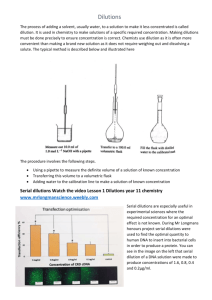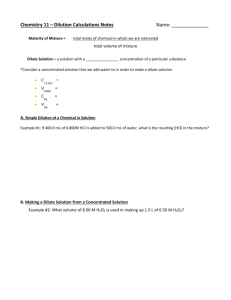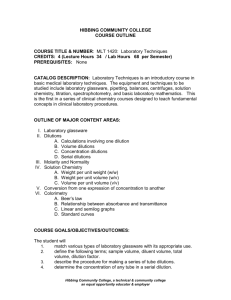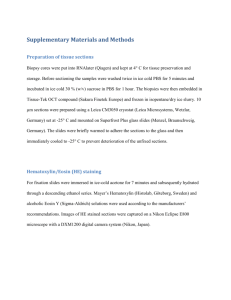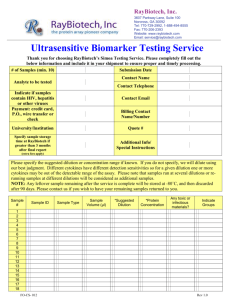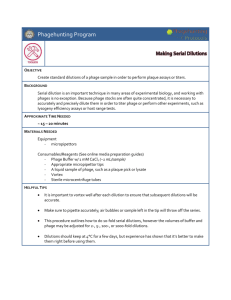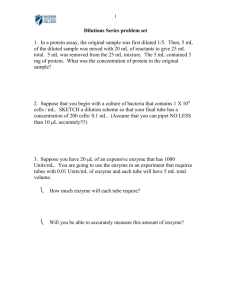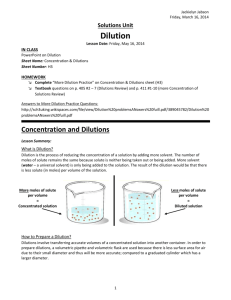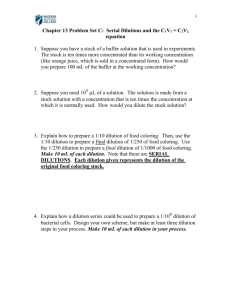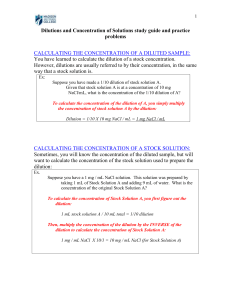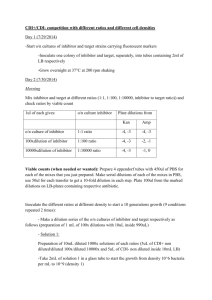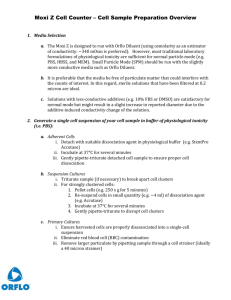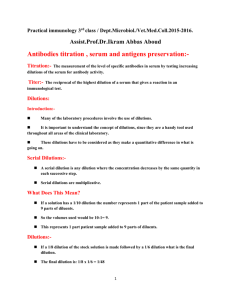Fort Lewis College
advertisement
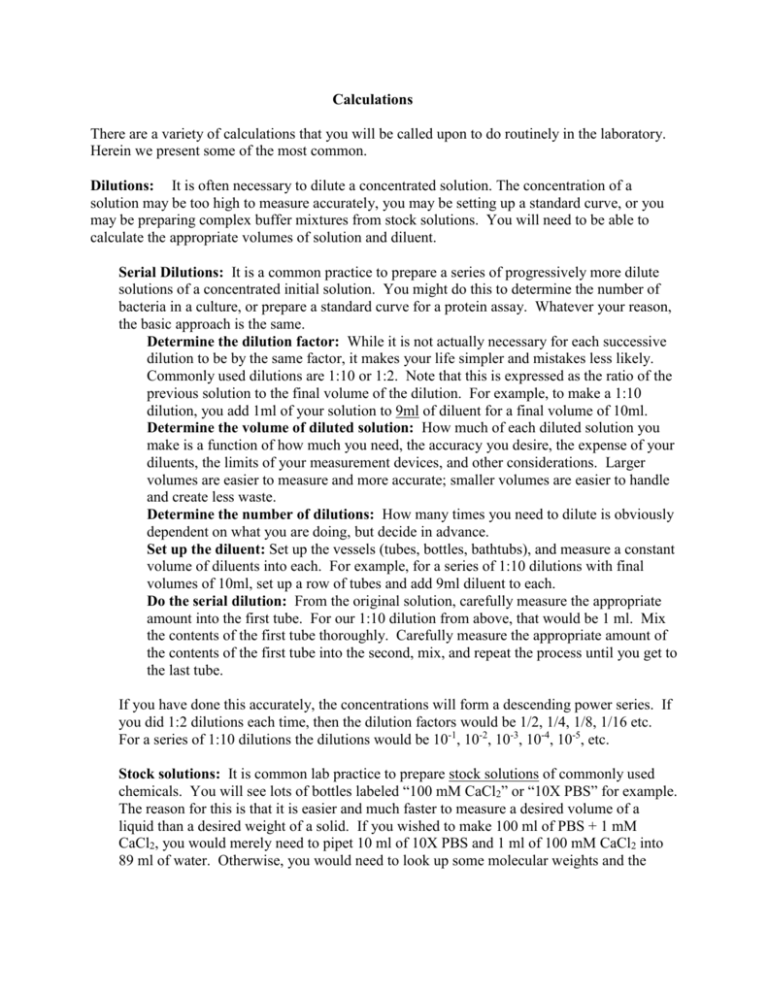
Calculations There are a variety of calculations that you will be called upon to do routinely in the laboratory. Herein we present some of the most common. Dilutions: It is often necessary to dilute a concentrated solution. The concentration of a solution may be too high to measure accurately, you may be setting up a standard curve, or you may be preparing complex buffer mixtures from stock solutions. You will need to be able to calculate the appropriate volumes of solution and diluent. Serial Dilutions: It is a common practice to prepare a series of progressively more dilute solutions of a concentrated initial solution. You might do this to determine the number of bacteria in a culture, or prepare a standard curve for a protein assay. Whatever your reason, the basic approach is the same. Determine the dilution factor: While it is not actually necessary for each successive dilution to be by the same factor, it makes your life simpler and mistakes less likely. Commonly used dilutions are 1:10 or 1:2. Note that this is expressed as the ratio of the previous solution to the final volume of the dilution. For example, to make a 1:10 dilution, you add 1ml of your solution to 9ml of diluent for a final volume of 10ml. Determine the volume of diluted solution: How much of each diluted solution you make is a function of how much you need, the accuracy you desire, the expense of your diluents, the limits of your measurement devices, and other considerations. Larger volumes are easier to measure and more accurate; smaller volumes are easier to handle and create less waste. Determine the number of dilutions: How many times you need to dilute is obviously dependent on what you are doing, but decide in advance. Set up the diluent: Set up the vessels (tubes, bottles, bathtubs), and measure a constant volume of diluents into each. For example, for a series of 1:10 dilutions with final volumes of 10ml, set up a row of tubes and add 9ml diluent to each. Do the serial dilution: From the original solution, carefully measure the appropriate amount into the first tube. For our 1:10 dilution from above, that would be 1 ml. Mix the contents of the first tube thoroughly. Carefully measure the appropriate amount of the contents of the first tube into the second, mix, and repeat the process until you get to the last tube. If you have done this accurately, the concentrations will form a descending power series. If you did 1:2 dilutions each time, then the dilution factors would be 1/2, 1/4, 1/8, 1/16 etc. For a series of 1:10 dilutions the dilutions would be 10-1, 10-2, 10-3, 10-4, 10-5, etc. Stock solutions: It is common lab practice to prepare stock solutions of commonly used chemicals. You will see lots of bottles labeled “100 mM CaCl2” or “10X PBS” for example. The reason for this is that it is easier and much faster to measure a desired volume of a liquid than a desired weight of a solid. If you wished to make 100 ml of PBS + 1 mM CaCl2, you would merely need to pipet 10 ml of 10X PBS and 1 ml of 100 mM CaCl2 into 89 ml of water. Otherwise, you would need to look up some molecular weights and the recipe for PBS and spend a bunch of time weighing small amounts of chemicals and preparing the solution. Using stock solutions is essentially an extension of the dilution concepts above. A stock solution is simply a concentrated solution which you will dilute before using. The 10X PBS above is phosphate-buffered saline made with 10 times the amount of solute. To make normal PBS, you simply add 1/10 volume of the 10X solution to 9/10 volume of water, eg. to make 60 ml of solution, you would add 6 ml 10x solution to 54 ml water. To make 100 ml of TBS from a 20X stock, you would add 1/20 of 100 ml (5 ml) of the stock and 19/20 (95 ml) of water. You see the pattern. If you have a concentrated solution of a chemical, such as the 100 mM CaCl2 above, you can use it to conveniently create solutions of lower concentration. The easiest way to calculate how much of this solution to add is to apply the dilution equation, C1V1=C2V2. For example, if you wanted to make 250 ml of a solution that contained 5mM CaCl2: 100 mM (x ml) = 5 mM (250 ml) Solving for x gives you 12.5 ml. This means you add 12.5 ml of 100mM CaCl2 to a final volume of 250 ml. Conversions: In laboratory situations you will be constantly expected to interconvert various measures of weights and volumes; molar (M) to millimolar (mM), microliters (µl) to milliliters (ml), or angstroms (Å) to kilometers (km), etc. One of the reasons that scientists use the decimal system is that making these conversions is merely a matter of moving the decimal point; there is no complicated arithmetic like there is when converting Gunter’s chains into miles. It facilitates the process that there are standard prefixes that can be applied to any base unit (grams, liters, molar) that always mean the same multiplier (giga-, nano, etc.). For you science geeks, here is a complete list of the prefixes and their numerical factors. yotta- (Y-) 1024 1 septillion zetta- (Z-) 1021 1 sextillion exa- (E-) 1018 1 quintillion peta- (P-) 1015 1 quadrillion tera- (T-) 1012 1 trillion giga- (G-) 109 1 billion mega- (M-) 106 1 million kilo- (k-) 103 1 thousand deci- (d-) 10-1 1 tenth centi- (c-) 10-2 1 hundredth milli- (m-) 10-3 1 thousandth micro- (µ-) 10-6 1 millionth nano- (n-) 10-9 1 billionth pico- (p-) 10-12 1 trillionth femto- (f-) 10-15 1 quadrillionth atto- (a-) 10-18 1 quintillionth zepto- (z-) 10-21 1 sextillionth yocto- (y-) 10-24 1 septillionth The only ones you will probably ever use are kilo-, centi-, milli-, micro-, and nano-. There is one other odd unit that you will probably run into, the angstrom; it is specifically 0.1 nm. To convert one measure to another, you just need to know the difference in the multipliers. To convert smaller units into larger ones, just move the decimal place to the left. For instance, 10µl=0.01 ml—micro is 10-6 and milli is 10-3 so move the decimal 3 places to the left. To convert larger units into smaller ones, just move the decimal place to the right. For instance, 0.015 L=150 ml—liter is 100 and milli is 10-3 so move the decimal 3 places to the right.

